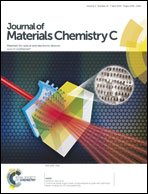A sequentially switchable molecular dielectric material tuned by the stepwise ordering in diisopropylammonium trifluoromethanesulfonate†
Abstract
A novel switchable and tunable molecular dielectric material, diisopropylammonium trifluoromethanesulfonate (1), which undergoes two reversible second-order solid state phase transitions at 200 K (TcL) and 340 K (TcH) respectively, has been successfully synthesized and grown as bulk crystals. The differential scanning calorimetry (DSC) measurements, and dielectric and variable-temperature single-crystal X-ray diffraction studies confirmed the stepwise phase transitions. 1 exhibits a remarkable temperature-dependent dielectric behavior, which could be tuned through three distinctive states triggered by the temperature change. Temperature-dependent single crystal structural analyses of 1 reveal a collection of exceptionally distinct and synchronous molecular motions of both the cationic and anionic moieties in 1, and that the interesting stepwise ordering of cations and anions are mainly responsible for its switchable and tunable dielectric properties. All of this demonstrates its potential application as a switchable and tunable molecular dielectric material.


 Please wait while we load your content...
Please wait while we load your content...